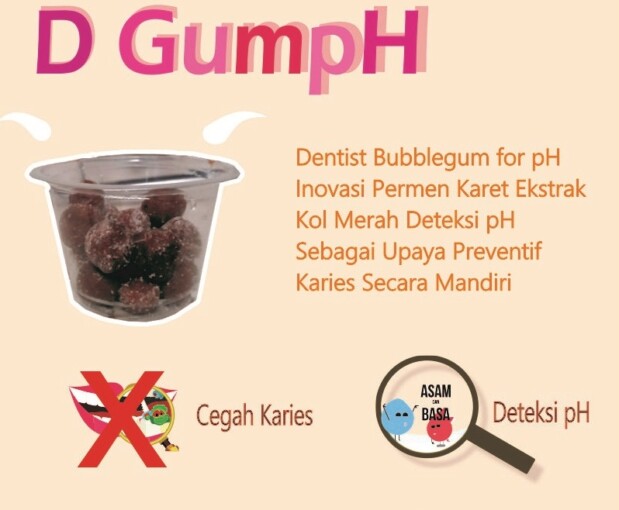Chewing gum is one of people’s favorite food that is consumed to reduce stress. Moreover, it can also clear out food remnants between teeth.
Inspired by this idea, two students from Dentistry and a student from Mathematics and Natural Sciences UGM created an innovative chewing gum from red cabbage extract named as D GumpH. This chewing gum differs from the others because it functions to detect the pH level of the mouth. Another function is to prevent dental caries or cavities.
Fifit Indriyanti, D GumpH team leader, informed the reason for choosing red cabbage extract as the material is because it contains anthocyanin dyes. Anthocyanins change colors under varying degrees of acidity (pH). In addition, it is also a flavonoid secondary metabolite with antibacterial activities.
Another reason is that red cabbage is easily found in Indonesia for salads. “Therefore, we want to make it as a chewing gum.”
Fifit carried out the study with two other students, Aprilia Nur Pratiwi and Ida Bagus Alit Rai Sugiharta. The study utilized grants from DIKTI through the Student Creativity Program 2018. Since April of this year, the three students attempted to make a chewing gum from red cabbage extract that can alter salivary color with different degrees of acidity. The color differences are later used to determine salivary conditions including acid, neutral, or alkaline. It aims to facilitate people in determining their salivary pH individually by chewing gums.
Aprilia Nur Pratiwi, the member of D GumpH team, explained the process of making D GumpH. First, the extracted red cabbage by maceration extraction using ethanol solvent and citric acid. Second, they tested the anthocyanin contents in red cabbage extract with UV-Vis spectrophotometer. Next, the extract was tested with buffer solution pH 1-13 and artificial saliva pH 5-9 to examine the color changes in both solutions.
“Qualitative test of the color will be used to match the color changes in artificial saliva after interacting with anthocyanin from the chewing gums.”
After several tests, the next step was making chewing gums. The process started with melting the gum base ingredient. The melt was then mixed with red cabbage extract. After that, xylitol was added and the mixture was shaped into small balls. “That is how we prepared the chewing gums.”
Ida Bagus Alit Rai Sugiharta, another member of D GumpH, said the obtained chewing gum cannot be consumed immediately. It needed a further test on artificial saliva pH 5-9. “We studied the color changes in saliva after a contact with D GumpH. We elaborated the color changes with the previous color qualitative test on the extract.”
Afterward, a testing of antibacterial activity against S.mutans was required for the red cabbage extract. The antibacterial testing was done on the various concentration of extracts that was compared to amoxicillin for its efficacy.
Their study showed that the color changes in artificial saliva with ph 5-9 were consecutively orange, brownish orange, brown, greenish brown, and green after combined with D GumpH. The color changes, according to Fifit, indicated that D GumpH is able to detect salivary pH of the mouth because the pH level usually ranges from 6 to 8.
Fifit continued, the percentage of in vitro D GumpH testing obtained was 80 percent. Then, the testing of the extract’s ability to inhibit the growth of caries-causing bacteria (S.mutans) also showed a positive result. “The extract can inhibit bacterial growth well, although less than amoxicillin.”
From the test results, Fifit opined, D GumpH should be considered to detect pH individually and to prevent dental caries. “Hopefully we can carry out in vivo testing and market the product,” she concluded.





